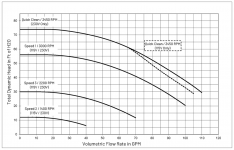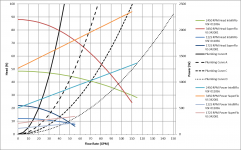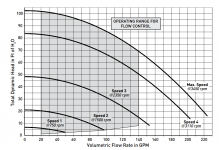For a cartridge filter, you don't need to backwash.Could also be an issue with backwashing.
For sand, you don't need more than 105 gpm, which it could easily do.
For DE, you don't need more than 60 gpm.
For a cartridge filter, you don't need to backwash.Could also be an issue with backwashing.



In my opinion, only poorly designed systems with excessive head loss will benefit from a 3,450 RPM design.
Most of the time this is true but as I said before, it is nice to have the higher flow rates when needed and I need it many times a year. I would never consider purchasing a handicapped pump just to reduce noise a tiny bit when my pump already very quite. It just doesn't make a lot of sense to me.Pools don't need more than 40 gpm, so even if poorly designed, it does not make much difference.
The pump will be able to do as much flow or more than your current pump if your system is well designed.Most of the time this is true but as I said before, it is nice to have the higher flow rates when needed and I need it many times a year. I would never consider purchasing a handicapped pump just to reduce noise a tiny bit

That's not the point.If you truly believe in the viability of this solution, take a SuperFlo motor/drive and put it on an Intelliflo wet end and compare the energy use and noise levels to that of the original Intelliflo.
I wasn't saying that the pump could not do more than 40 gpm, I was saying that there are many people who never run the pump over 40 gpm.I was referring to the 40 GPM cap you mentioned and that for me is way too low and I think it would be too low for most people.
It's like if you buy a car and get an 800 hp engine and then just drive it at normal speed limits.
Is it really worth the extra cost to have the big engine if you will never use it?
HP in automobiles isn't as much for top speed as it is for acceleration. That is much more important for times such as getting on the freeway.
If you change the top speed to 2,750 RPM and increased the impeller accordingly, then that would still give you more than enough power to achieve any flow rate you want.But even for pumps, in some cases it is worth the larger HP if it lasts longer plus gives you more head room for faster cleanups.
I don't know if you own a pool since your sig doesn't contain one but having the ability to run at higher flow rates is definitely a plus for some pool owners.


